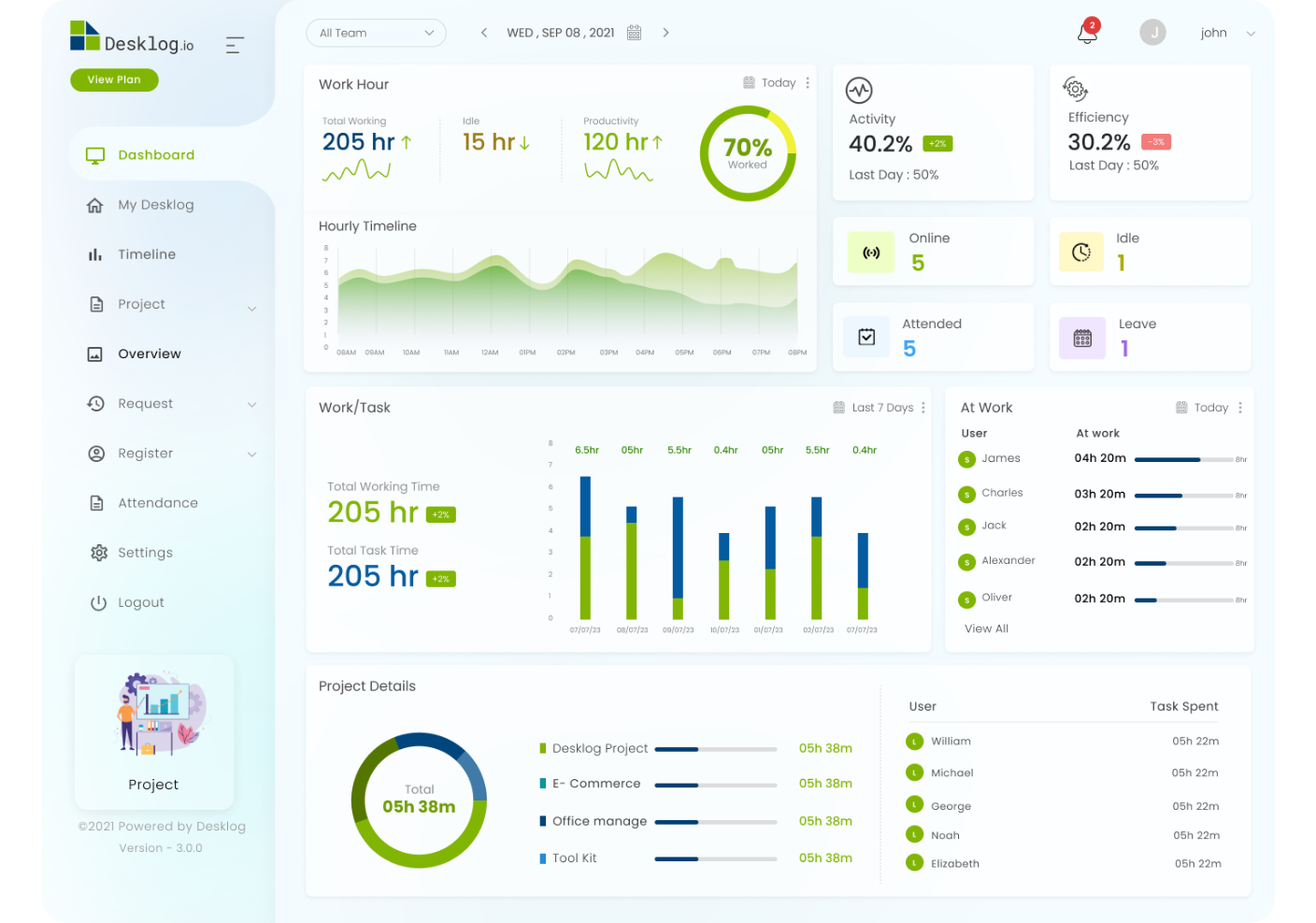
What is a Hybrid Workplace Model and How Does it Ensure Employee Productivity?
Not so long ago, companies all over the world were forced to adopt remote working due to the COVID-19 pandemic. And to the surprise of many, remote working turned out to be highly effective and productive for most employees. Even professionals who would never have considered working remotely as a viable option such as trainers, doctors, and therapists found remarkable success. Misconceptions such as remote work would hamper productivity were mostly blown away.
Even after the pandemic restrictions were lifted, many employees still prefer to work from the comforts of their homes. The success of remote work has reimagined the role of offices in modern work culture. According to PwC’s US Remote Work Survey, more than half the workforce would like to work from home for at least 3 days a week. Big-name companies all over the world such as Microsoft, Quora, Dropbox have adopted a hybrid working model which combines the best of remote working and office work. But what exactly is the Hybrid Workplace Model? What are the pros and cons? How Does it Ensure Employee Productivity? And how can you successfully implement the Hybrid Workplace Model? Let’s have a look.
What is the Hybrid Workplace Model?
The hybrid workplace model is a mix of remote working and working from the office. You will have employees working from home and office. They can work from home for a few days a week and report at the office for the remaining days. This allows increased freedom for employees and their jobs can be structured based on their lifestyle rather than structuring their lifestyle based on their jobs.
Hybrid working can be implemented in different ways. It can be similar to a completely remote company, with certain exemptions. Some employees, whose duties require their physical presence would have to work from the office while others work remotely. Some companies implement the hybrid working model by requiring employees to work at the office for a few days a week or when there are collaborative tasks. Allowing employees to work remotely for a few days a month while maintaining the office as the primary workspace also counts as a hybrid working model.
The hybrid workplace model intends to provide employees with a better work-life balance, increased productivity, and reduced stress and commuting.
Learn More about the Pros & Cons of Work From Home Vs Office
Want to try our Time Tracking Software?
Try Desklog for free!

Pros of the Hybrid Workplace model
Employee first approach
The Hybrid Workplace model prioritizes the employees over everything. Every employee would welcome an escape from their daily commute and a better work-life balance. As mentioned earlier the hybrid workplace model enables employees to structure their work according to their lifestyle rather than structuring their lifestyle according to their work.
Economical
The hybrid workplace model eliminates the need for large office space. Without the need for large extravagant offices, companies can save huge amounts of money on real estate and office maintenance costs. These economical resources can be put to better use for the betterment of products and services or employee welfare.
Access to better talent
If employees are not required to be physically in the office, then they might as well be from any part of the world. This provides companies access to talent from all over the world. They can collaborate with teammates through video calls and conduct collaborative actions together.
Safety
The hybrid workplace model is the safest practice in the middle of a global pandemic. Social distancing and COVID mandates cannot be followed properly if all the employees are working from the office. The hybrid workplace model minimizes the chance of your employees becoming infected.
Hire Across The Globe
Hybrid workplace models help to choose employees from a wider range of talent pools. The remote working that is integrated with the hybrid workplace model removes the struggles to habitat employees to a workplace and culture that are spread far from their spaces of comfort and home.
Nurture a Crisis resilient culture
The world has always been dynamic and uncertain. The pandemic has added up further uncertainty into it. A hybrid workplace model helps companies to nurture a workforce that is well trained to work through every calamity. This brings immense confidence to companies while facing uncertain working conditions brought by the disasters like the pandemic.
Flexibility in timing
Every new day harbors new challenges that are very different for each one of us. This makes our hour of convenience very different from each other. The remote working that is coupled with a hybrid workplace model helps employers to work at their hour of comfort. Each employee will be able to choose their hour of convenience as there would be no road blocks due to travel restrictions, office closing, and opening time due to security reasons. Employees can work in times of health issues with intermediate breaks and at hours that breed them the most comfort.
Saving Travel
Traveling is a leisure activity. But not traveling that involves hustling to your workplace. The cost and labor involved in traveling are huge. Cutting traveling off from the day and adding it to productive working hours is a dream for many. Remote working helps to achieve this.
Helps Cut The Boredom And Fill The Voids
Office does not always work and hustle. The eavesdropping, the jokes, and friendships are greatly missed in remote working. A hybrid working model opens doors to those peers who wish their office doors would remain open for them. There are always various voids that require teams to gather in person to get tasks done as well.
Communicate your plan
Most employees who are under remote working, hybrid, or at the office are muddled in their thoughts of what their companies are planning for the future. There could be employees who joined the office only because the company called for remote employment. Communicating about the change in the working plans all of a sudden can disrupt and make it impossible for many people to continue working with the changed plans in their working culture. Many talented people would bounce out of the idea of joining your office by speculating the office could shift their working culture in near future. Therefore communication about the future work culture plans, whether in-house or remote should be clearly communicated. This would help employees to reorient their life plans according to that.
Cons of the Hybrid Workplace model
Inequality
The hybrid workplace model cannot be equally implemented across all professions. Some jobs require employees to be physically present at their workplaces. Additionally, not all employees working remotely will have quality internet connectivity, proper home workspaces, or distraction-free circumstances.
Collaboration and Communication
Even though there are more ways to stay connected with your teammates than any time before, collaboration and communication are a problems when working remotely. People also tend to work at their own schedule while working remotely. This may be an obstacle because different employees will be working on different schedules. Collaboration and communication like in the office are difficult to achieve in the hybrid workplace model.
Remote meetings are not ideal grounds for effective large party meetings. This can result in missing out on important conversations due to various issues.
Social Persona development will find little grounds for its growth. This can result in a huge setback for many employees
Tips to successfully implement the Hybrid Workplace Model
Educate Employees About Hybrid Workplace Model
Your workers must understand their way around the hybrid work model. They should recognize that hybrid work will be different from working in the office. Instruct them regarding the difficulties their team members may encounter. So they can understand better and develop collaboration.
Create a Hybrid Workplace Policy
Employees who are not working from the office may feel that they are not treated equally. And those working from the office cannot enjoy the same flexibility as remote employees. Remote employees may have to work more hours as they can save the time taken for daily commute. All these disparities can be addressed through a proper Hybrid Workplace Policy.
Use employee time and productivity tracking software
Deploying employee time and productivity tracking software can ease out most of the difficulties of the hybrid workplace model. Using an employee tracker like Desklog will let you know the productivity, time spent working, and much more of remote and on-site employees. Desklog’s features include:
- Automatic time and productivity tracking.
- In-depth productivity reports on a day, week, or monthly basis.
- Optional screenshots of employees’ screens.
- Lightweight software for Windows, Linux, and Mac.
Conclusion
We are seeing more and more companies warm up to the Hybrid workplace model. Here we have discussed the Hybrid workplace model, its pros and cons, and tips to successfully implement it in your company. Is this how the workplaces of the future will be? Only time can tell. But employee time and productivity tracking software like Desklog has made the Hybrid workplace model a lot easier for both employers and employees.


